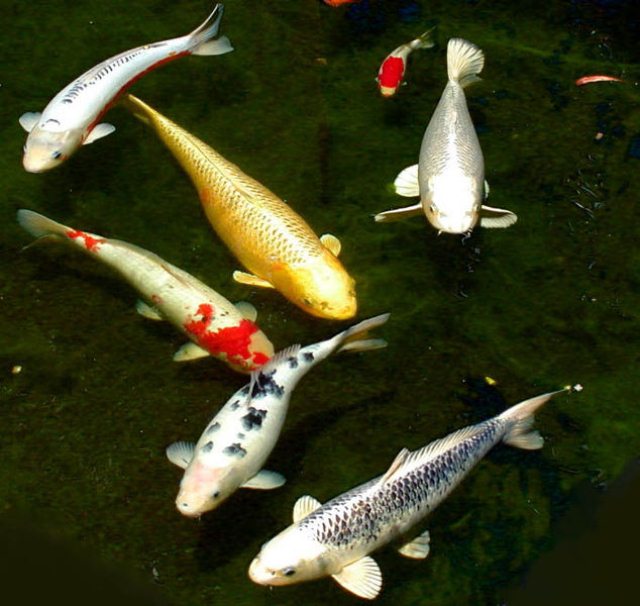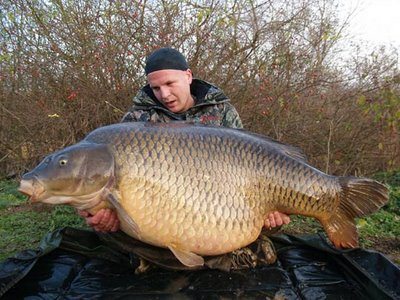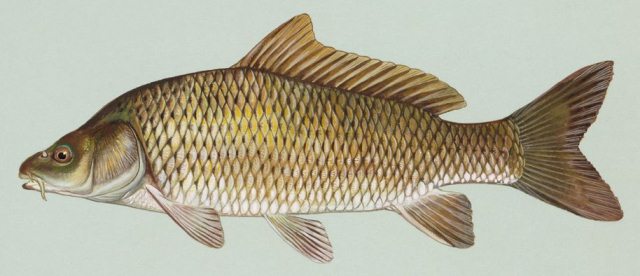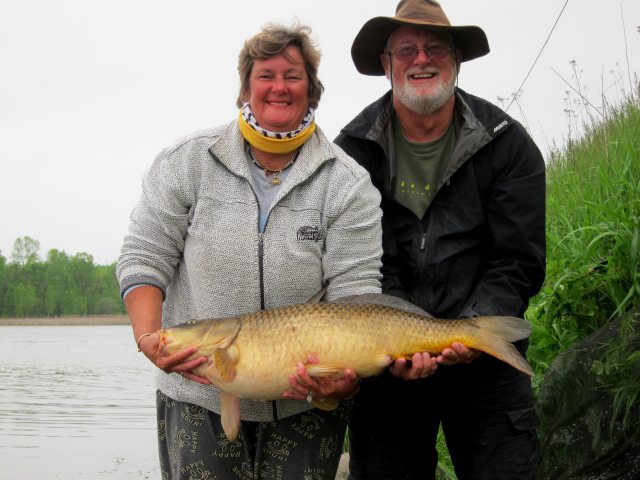|
Carp
Carp are various species
of oily freshwater
fish of the family
Cyprinidae, a very large group
of fish native to Europe and Asia. Carp have long been an important food fish to
humans, as well as popular ornamental fishes such as the various goldfish breeds and the
domesticated common carp variety known as koi. As a result, carp
have been introduced to various locations, though with mixed results. Several
species of carp are listed as invasive species by the U.S. Department of
Agriculture, and worldwide large sums of money are spent on carp control. Bear and his 'little one', weighing in at
thirty one pounds.
Aquaculture: Various species of carp have been
domesticated and reared as food fish across Europe and Asia for thousands of
years. These various species appear to have been domesticated
independently, as the various domesticated carp species are native to different
parts of Eurasia. For example, the Common Carp Cyprinus carpio are originally from Central Europe.
Several carp species (collectively known as Asian Carp) were domesticated in East Asia. Carp that are originally from South Asia, for example catla (Gibelion catla), rohu (Labeo rohita) and mrigal (Cirrhinus cirrhosus),
are known as Indian carp. Their hardiness and adaptability have allowed
domesticated species to be propagated all around the world. Although initially
the carp was an important aquatic food item, as more fish species have become
readily available for the table, the importance of carp culture in Western
Europe has become less important because
of declining demand, partly due to the appearance of more desirable table fish
such as trout and salmon through intensive farming, and
environmental constraints. However, fish production in ponds is still a major
form of aquaculture in Central/Eastern Europe, including the Russian
Federation where most of the
production comes from low intensity or semi-intensive ponds. In Asia, the
farming of carp continues to surpass the total amount of farmed fish volume of
intensively sea-farmed species such as salmon and tuna.

Six different coloured koi and a smaller
goldfish.
As Ornamental
fish: Carp,
along with many of their cyprinid
relatives, are popular ornamental aquarium and pond fish. The two most notable
ornamental carps are goldfish
and koi.
Goldfish and koi have advantages over most other ornamental fishes, in that they
are tolerant of cold (they can survive in water temperatures as low as 4 degrees
Celsius), can survive at low oxygen levels, and can tolerate low water quality.
Goldfish (Carassius auratus) were originally domesticated from the
Prussian carp (Carassius gibelio), a dark greyish brown carp native to Asia.
They were first bred for colour in China over a thousand years ago. Due to
selective breeding, goldfish have been developed into many distinct breeds and
are found in various colours, colour patterns, forms and sizes far different
from those of the original carp. Goldfish were kept as ornamental fish in
China
for hundreds of years before being introduced to Japan
in the 15th century, and to Europe
in the late 17th century. Koi are a domesticated variety of common
carp
(Cyprinus carpio) that have been selectively culled for colour. The
common carp was introduced from China to Japan, where selective breeding of the
common carp in the 1820’s in the Niigata region resulted in koi.
In Japanese culture, koi are treated with affection, and seen as good luck. They
are popular in other parts of the world as outdoor pond fish. Apparently, £460,000 is the current record price paid for a
Koi. On average the majority of Koi sell for £5-£25.

As sport fish:
Izaak
Walton
(9th August 1593 – 15th December 1683) said
about carp in The
Compleat Angler,
"The Carp is the queen of rivers; a stately, a good and a very subtle fish; that
was not at first bred, nor hath been long in England, but is now
naturalised."

Carp are
variable in terms of angling
value: In Europe,
even when not fished for food, they are eagerly sought by anglers, being
considered highly prized coarse
fish that are
difficult to hook. The UK has a thriving carp angling market. It is the fastest
growing angling market in the UK and has spawned a number of specialised carp
angling publications such as 'Carpology', 'advanced carp fishing', 'carpworld'
and 'TotalCarp' also many an informative carp angling web site such as
Carpfishing UK, Carpit and obviously our favourite www.canadiancarpclub.on.ca
In the United States, the carp is also classified as a rough
fish as well
as damaging naturalised exotic species but with sporting qualities. Many states'
departments of natural resources are beginning to view the carp as an angling
fish instead of a maligned pest. Groups such as the Carp Anglers
Group and
American Carp Society promote
the sport and work with fisheries departments to organize events to introduce
and expose others to the unique opportunity the carp offers freshwater anglers.
Rod and reel are often traded for bow and arrow.

This is a picture of the biggest carp ever caught
on rod and line, and a new world record carp, weighing in at a colossal
99lb. The captor, British angler Ambrose Smith, admitted he ‘felt like doing a
somersault’ after catching the new world record carp from The Graviers fishery,
near Dijon, in France. As well as smashing the former record, set by fellow UK angler Martin
Locke in January with a 94lb carp from another French venue, Rainbow Lake, the
huge mirror, which is known as the ‘Scar Fish’, also obliterated Ambrose’s
personal best of 57lb.

One angling guide
from Thailand has managed to catch what is believed to be the largest carp ever
caught in the history of sport fishing. Fishing Adventures
Thailand professional guide Kik's carp was found to weigh some 265 pounds after he caught it on the Bung Sam Lan Lake on
the 2nd of July 2007.
A
British fish fan has taken delivery of the world's biggest koi carp - a 4ft
monster that tips the scales at a staggering six-and-a-half-stone. The
mammoth fish - nicknamed the Big Girl - is the size
of a 12-year-old child and three times larger than any other carp in the UK.
Enthusiast
Geoff Lawton paid an undisclosed sum for the 17-year-old koi from a specialist
breeder in Japan. But he has already put a £30,000 plus price tag on the 90lbs
specimen.
As Tattoo designs: Very
popular especially among the Japanese.
ALL IN
ALL WE LIKE THEM
BIG FISH, BIG FIGHTERS, HUGE
FUN
|












